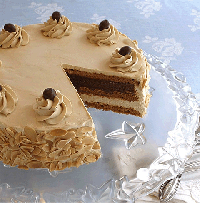 Whipping eggs (whole and/or yolks only or whites only), usually with sugar, is called the EGG FOAMING METHOD. Beaten eggs are one of the keys to success in making UNSHORTENED (FOAM) CAKES, such as Angel Food, Sponge or Chiffon Cakes. It is beaten eggs that give the structure and puff or leavening to the recipe, especially whites. (A beaten egg white can increase six to eight times its original volume.) Candies and icings or frostings include whipped egg whites in their recipes to inhibit crystals from forming. Beaten egg whites can be folded into Chocolate Mousse to help aerate the recipe.
Whipping eggs (whole and/or yolks only or whites only), usually with sugar, is called the EGG FOAMING METHOD. Beaten eggs are one of the keys to success in making UNSHORTENED (FOAM) CAKES, such as Angel Food, Sponge or Chiffon Cakes. It is beaten eggs that give the structure and puff or leavening to the recipe, especially whites. (A beaten egg white can increase six to eight times its original volume.) Candies and icings or frostings include whipped egg whites in their recipes to inhibit crystals from forming. Beaten egg whites can be folded into Chocolate Mousse to help aerate the recipe.
Separated and beaten egg whites have multiple uses in baking recipes, and the peak stiffness achieved during their preparation describes their consistency. Recipes will typically call for soft to stiff peaks. If used for leavening, beaten egg whites are usually folded into other ingredients, done with Priscilla's Orange Sponge Cake Recipe or the Moist, Very Chocolaty Chocolate Chiffon Cake Recipe, or the Ladyfingers Step-by-Step Recipe.
SARAH SAYS: Preheating the oven, using an oven thermometer and placing egg white leavened recipes in the lower third of the oven, encourages rising.
Beating egg whites should begin slowly at the beginning. The friction from the beating gently warms the whites, allowing its proteins proteins to improve their elasticity so the they to take on air more easily and eventually gain more volume.
SARAH SAYS: It is not necessary to start with room temperature whites because with today's electric mixers, they generate enough friction to quickly warm the whites to the right temperature for beating. It's really the age of the whites you need to be concerned about; the fresher the better, in most cases, when using today's eggs from commercial grocery store outlets.
SUGAR
Sugar is often added when beating egg whites, and depending on the amount used, it is technically called a Soft or Hard Meringue. Sugar interacts with the egg white proteins to help stabilize the whipped egg foam, which is essentially a delicate protein network. It is very important to be aware of when you add the sugar while beating the egg whites. Always add sugar in a stream, slowly at the side of the bowl while the whites are being whipped; do not dump it in the center — you don't want to risk deflating the whites.
SARAH SAYS: If a whipped egg white recipe does not include sugar, and the egg whites will eventually be folded into a base, I recommend adding in a couple of tablespoons of white sugar, taken from the recipe; a small amount will stabilize the whipped whites.
Adding in sugar has many benefits. Sugar pulls the water from the structure and allows it to hold its shape better; egg whites beaten without sugar will not peak as firmly as those with. Beaten whites can also sit and hold their shape longer than foams without sugar. Sugar makes the egg foam more elastic so that air cells can expand and take up gases from the leavening agent. Sugar stabilizes the batter and also delays the evaporation of water from the egg white foam in the oven. This is good because it allows its protein structure ample time to rise and then set.
CREAM OF TARTAR OR LEMON JUICE
When beating egg whites, an acid, such as cream of tartar, freshly squeezed lemon juice, or distilled white vinegar (not white wine vinegar) is used to help prevent overbeating. Adding small amounts helps to stabilize them and allows the beaten whites to reach their full volume and stiffness; too much has the opposite effect. It has been found that cream of tartar works the best, and also serves to whiten the egg white foam. Cream of tartar helps to produce a finer grained and high volume cake. It does this by keeping the foam supple and elastic, but stable, so it can expand to its fullest when baked. Cream of tartar isn't easily found in all parts of the country, though, so you can substitute it.
SARAH SAYS: In general, for each 1 large egg white, use 1/8 teaspoon cream of tartar or 1/4 teaspoon freshly squeezed lemon juice or 1/4 teaspoon distilled white vinegar. Up to 1 teaspoon cream of tartar per 1 cup egg whites.
NOTE: Pasteurized egg whites NEED cream of tartar or lemon juice added so you can be able to beat to a stiff meringue. You will need double the amount. For example, for cream of tartar for pasteurized eggs: for 1 pasteurized egg white use 1/4 teaspoon of cream of tartar.
SALT
Many recipes call for adding in salt, but I do not recommend it. It is now thought to act as a destabilizer, instead of a stablizer, but only to a very small degree. Instead, add it to the flour and other dry ingredients, or with the rest of the recipe.
Sometimes water is added when beating egg whites. It can aid in the increase of the volume of egg white foam, but too much can decrease its stability.
EGG SAFETY
EQUIPMENT
Which one – A hand-held electric mixer or a stand mixer? (Never use a blender.) Beaters can make a difference in volume depending upon the number of egg whites beaten at one time. (Small amounts are 4 or less large egg whites; large amounts are 4 or more). I advise using a stand mixer when you have 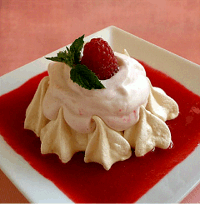 a large amount of egg whites to beat. Any amount under 4 large eggs whites, can be beaten with a hand-held mixer or using a balloon whisk. Some classicists use a large balloon whisk and a copper bowl, when beating by hand for any amounts.
a large amount of egg whites to beat. Any amount under 4 large eggs whites, can be beaten with a hand-held mixer or using a balloon whisk. Some classicists use a large balloon whisk and a copper bowl, when beating by hand for any amounts.
QUESTION: Does the type of mixing bowl really matter when whipping egg whites?
SARAH SAYS: When whipping egg whites, use either a deep copper or stainless steel bowls with straight sides. It must be spotless and dry.
The composition of the bowl in which you beat egg whites can make a big difference. A copper bowl reacts chemically with egg whites to form fluffy, high-rise whites – it contains an ion which reacts with an egg white protein, specifically conalbumin, to form a more stable foam and helps the whites retain moisture. Do not add in cream of tartar because it isn't necessary when using a copper bowl. The same result can be obtained using stainless steel or glass bowls with the addition of cream of tartar. However, I don't use a glass bowl because I have found that when using it, its naturally slick surface doesn't give much traction for the egg whites to climb the bowl.
Avoid plastic or wooden bowls because of their naturally porous surface which attracts grease because of its porous surface; grease or fat deflates egg whites. Never use aluminum which reacts with the egg whites causing them to turn slightly gray. If beating by hand, the mixing bowl should be 9 to 10 inches in diameter and 5 to 6 inches deep,
EGG TEMPERATURE
Typically room temperature egg whites are called for in recipes, but I have found that ones cold from the refrigerator also work well. Colder eggs may take a few seconds longer to beat, but their maximum volume will be achieved. The real issue with egg whites is their freshness, not temperature, so you can beat whites right from the refrigerator, althought they may require slightly more beating time. Newer fresh eggs have thicker whites and will reach more volume and have greater stability when beaten than older eggs.
HOW TO BEAT EGG WHITES WITH A STAND MIXER
Beat the egg whites with cream of tartar and sugar:
1. Place egg whites in a clean, dry spotless mixer bowl of a stand mixer. Make sure there are no egg yolks or shells in the mixture.
SARAH SAYS: It is very important that anything that comes in contact with the egg whites is clean and completely free from any grease, oil or fat of any kind. Even a tiny drop of the yolk mixed in with the whites will keep the whites from accepting air. This is also true with your whisk or beaters.
Before starting, wipe the clean implements with lemon juice or white wine vinegar, rinse both in warm water, and then dry. Don't use plastic containers because they tend to absorb and retain fat even if washed.
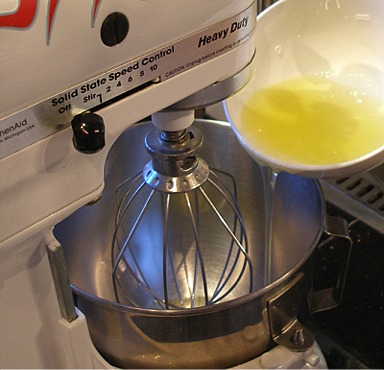
2. With a stand mixer fitted with a whisk attachment, beat egg whites on low to medium-low until foaming, taking about 1 minute.
SARAH SAYS: This beginning step is one of the most overlooked and important steps. If egg whites are beaten too quickly at the beginning, the structure of the foam will not be as strong, and later the egg whites will not beat as high as they should – about 10 percent more voluminous than the high-speed-only whites, resulting in meringue cookies and frosting that were lighter and airier, with larger cookies.
As air is beaten into the egg whites, they will start to lighten in color with large air bubbles.
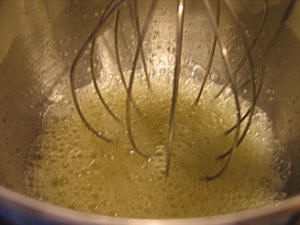
3. Keep mixing the egg whites on low to medium-low speed. The egg white foam will increase in volume and become white and the size of the air bubbles will start to decrease.
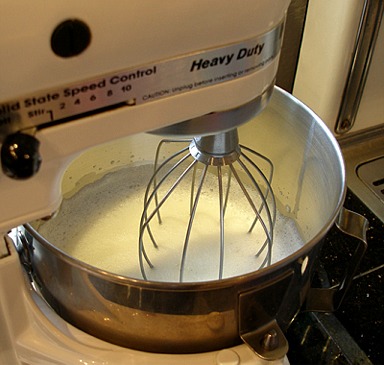
4. When the egg white foam increases in volume with smaller bubbles, immediately add the cream of tartar at the side of the bowl. Do NOT add in salt.
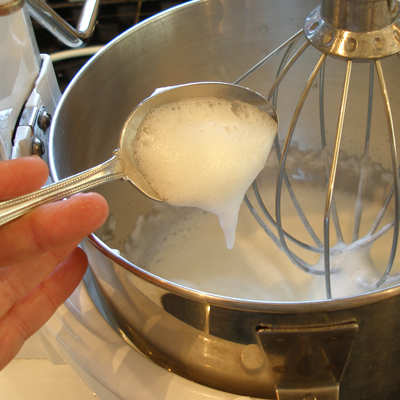
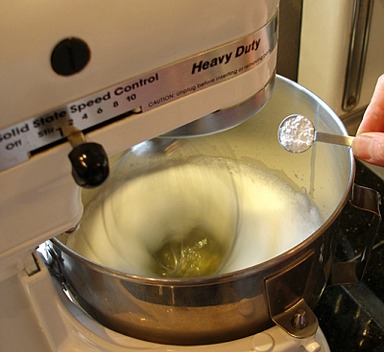
5. After adding, increase the mixer speed to medium.
The bubbles in the egg white foam will become smaller and more even in size. When it reaches this stage, increase the mixer speed to medium-high.
6. When the egg whites have increased approximately 4 times in volume, add the sugar slowly in a steady stream at the side of the bowl.
After the sugar has been added, increase the mixer speed to high.
SARAH SAYS: Always add sugar in a stream, slowly at the side of the bowl while the whites are being whipped; do not dump it in the center — you don't want to risk deflating the whites.
NOTE: Sometimes recipes call for adding in the sugar during the peak stages, below, rather than here. Follow each recipe's instructions.
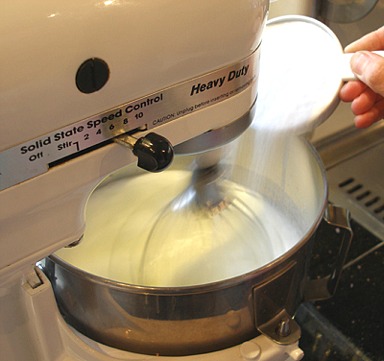
7. Peak Stages: Your egg whites can now be beaten from soft to stiff peaks.
Sometimes a firm peak stage is called for; it is in between a soft and stiff peak stage. When the mixer is stopped and the beater lifted, the egg white's peak should hold and then curl slightly at the end.
A. SOFT PEAK STAGE
Continue to beat on high until the egg white foam becomes glossy. This is called the soft peak stage. It is reached when the peaks of the whites droop when the beater is turned off and lifted. Add the vanilla or any extracts in the final moments of whipping, unless beating to a stiff peak stage..
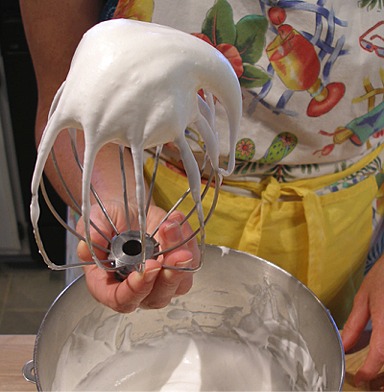
B. STIFF PEAK STAGE
Continue to beat on high until the egg whites are white, fluffy, firm and still very glossy called the Stiff Peak Stage. Add the vanilla or any extracts in the final moments of whipping.
The whites will start to form lumps as the mixer beats. STOP beating when they do, as shown in the photo; that means in a few seconds, your whites will begin to overbeat.
SARAH SAYS: If egg whites are beaten to dry and dull, they are overbeaten — Watch carefully, because egg whites can go from stiff to dry and overbeaten in as little as 30 seconds.
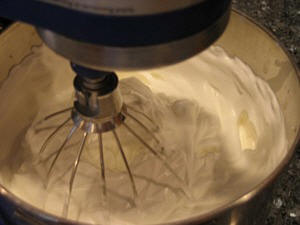
A test to perform to see if your egg whites are stiffly beaten is to stop the beaters and then lift them — the peak should hold. If not, continue beating for a few seconds more and perform the test, again.
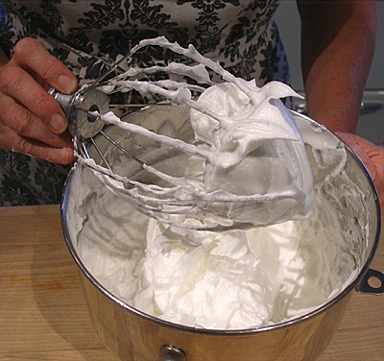
With stiffly beaten egg whites, you can gently cut a table or icing knife through the middle; it creates a narrow grove with stiff walls.
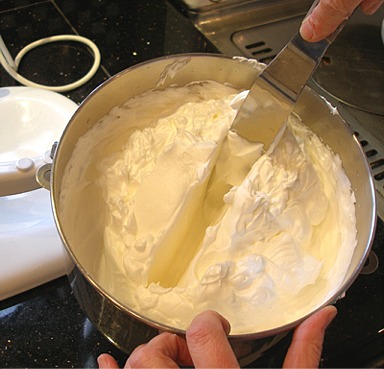
8. Use your whites in the recipe immediately upon beating them. If they sit for more than 10 minutes, they lose stability start to start to deflate, so whip again by hand with a whisk, if they do. They will keep a bit longer if the foam contains sugar and an acid, such as cream of tartar or lemon juice. Generally speaking, the more sugar that has been whipped into the whites, such as for a meringue, the longer they will hold their volume and stiffness without deflating as it is shaped.
QUESTION: HELP! I've overbeaten my egg white mixture. Do I have to throw them out and start again! I just wasted twelve eggs and all of the time separating them…I'm heart broken!
SARAH SAYS: Do not overbeat the egg whites; if they are beaten too stiff, they lose their gloss and look curdled or grainy. Unfortunately, there is no more stretch left for them to rise when baked — some or will pop during the whipping stage and will collapse. To fix, try whisking in another egg white with a wire whisk — DO NOT use the electric mixer. If you can't fix them, unfortunately, you have to start over again with fresh egg whites.
HOW TO BEAT EGG WHITES WITH A HAND HELD MIXER
SARAH SAYS: I recommend using a hand-held electric mixer or a wire whiskfor beating any amount under 4 large eggs whites. When using a hand held mixer, make sure you circulate it through the mixture as though it were a whisk.
1. In a medium size deep bowl, with straight sides, beat the egg whites on low until foamy.
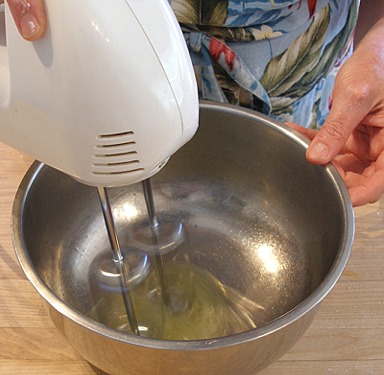
2. Add the cream of tartar.
Increase the mixer speed to high and beat until soft peaks form when the beater is raised.
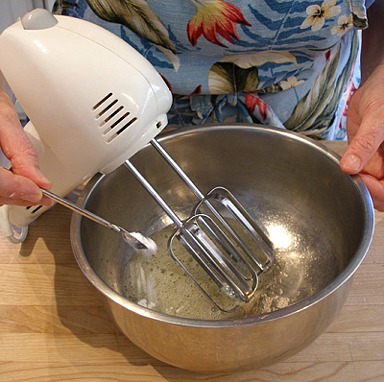
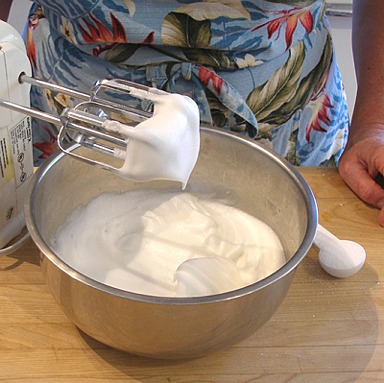
3. Add the sugar slowly at the side of the bowl.
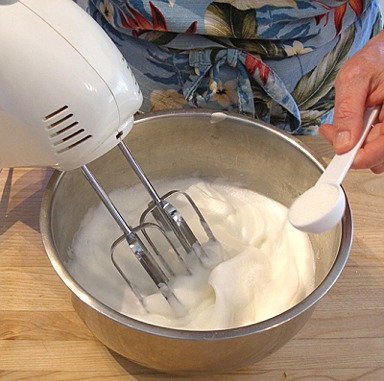
4. Continue to beat on high until soft or stiff peaks form when the beater is raised.
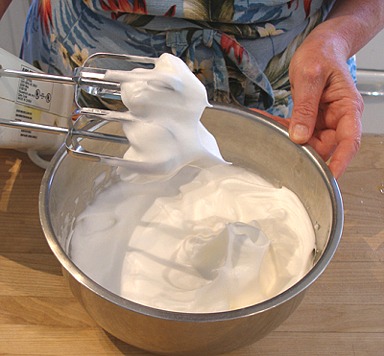
5. Scrape down sides of bowl before using.


